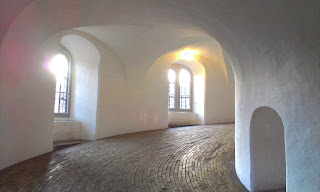Disclaimer: This post does not contain a whole lot of pretty pictures and is filled with Sciency stuff. Consider yourself warned.
A little background to begin...Tycho Brahe was a Danish nobleman who made some astronomical discoveries in the 1500s. Literally astronomical, as in new stars and calculations that would allow Johannes Kepler to form the basis for the laws of planetary motion. Smart guy. Except he got into a disagreement with a cousin over the validity of a mathematical formula. Neither could convince the other he was right, so they agreed to a sword duel. Really. Check Wikipedia. Tycho lost the bridge of his nose in the duel and forever after wore a metal plate in its place. Sometimes silver, sometimes gold, perhaps even copper (it was a heck of a lot lighter). This has absolutely nothing to do with the building I visited last weekend, I'm just a big Brahe fan.
Anyway, Tycho had become a bit of a celebrity in the Astronomy field and King Frederick II wanted to keep him in Denmark, so the king gifted Tycho with an island and the funds to build his own observatory, which he built and ran as an institute for several years. I wonder if I can visit the island...mental note for future explorations. Anyway, King Frederick died and his 11-year-old son Christian became king in 1588. Tycho and the new king did not get along and eventually the astronomer moved to Prague and became the Royal Astronomer under Holy Roman Emperor Rudolph II. Did you know there were not one but two Holy Roman Emperors named Rudolph?
When Tycho left Denmark, Christian Longomontanus became the new Royal Astronomer of Denmark. I don't think he made any particularly important contributions to his field because I had to check the spelling on his last name three times. But he was influential with the new king and convinced King Christian IV to build a new observatory for the University of Copenhagen. At the time, the University was also looking to build a library and a church. Danes being efficient men, they combined them all into one building. There are several dozen snarky comments running around in my head about one building devoted to both science and God, but I'll be nice and keep them to myself. What resulted was the Rundetårn, which translates as the Round Tower. Creative, I know.

The observatory is the tall round tower on the left, the church is the main part of the building on the right, and the library was in the church attic. One problem with this set-up was that they had to get lots and lots of heavy books and observatory equipment up to the top of this building. Their solution? Eliminate the stairs.
The observatory tower has seven and a half turns from bottom to top and its one giant ramp so they could pull the books up with a horse and cart. The builders of the W.E.B. Du Bois libarary could have learned a thing or two from these guys.
In 1726, Czar Peter the Great ascended the tower on horseback to look at the stars. Unfortunately its no longer an official observatory, though they do hold amateur stargazer get-togethers up there. They've had several bicycle races inside the tower and in 1989 Thomas Olsen set a world record when he rode a unicycle up and down the tower in 1 minute, 48.7 seconds. But the best thing about the tower are the views from the top. They're out of this world. You can see the tiny windmills in the sound to the left of the 4 smoke stacks and waaaay off in the distance is Sweden. (hint: if you click on the pictures, they get bigger)






No comments:
Post a Comment